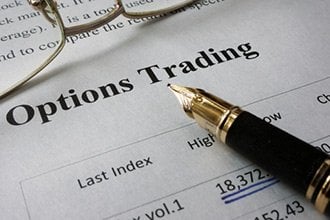Options and futures are both contracts to buy and sell either a stock or commodity at a specific price by a specific time. So in the broadest sense, they are similar.
But if you look more closely, you'll find they have some important differences. What separates them lies in the words "options" and "futures."
 An options contract literally gives the holder the "option" to buy or sell a stock at some future date. A futures contract, on the other hand, is more of a commitment. It requires the purchase or sale of the product at a future date.
An options contract literally gives the holder the "option" to buy or sell a stock at some future date. A futures contract, on the other hand, is more of a commitment. It requires the purchase or sale of the product at a future date.
Futures contracts are written on units of commodities - barrels of oil, tons of steel, etc. The contract sets a date, price, and quantity of the commodity being traded.
Because futures can be complicated, they're mostly traded by institutional investors and industry. Industry players sometimes want to hedge relevant commodities - for example, airlines buy fuel futures and builders buy steel futures.
That said, there's money to be made in futures trading. Big firms can hedge their costs with futures. Or retail investors can make money from the direction of a stock in one direction or another.
Futures trading is a bit riskier and more complicated than trading options. A big investment is required to make any significant profit on small price movements in futures trading. So investors typically borrow a lot of money - or margin - when trading them.
But making money with options doesn't need to be as risky. In fact, we're going to show you an options play that you can profit from no matter what happens to a stock - it limits the risk in any scenario.
Then, once you know a few options trading basics, you can choose to venture into more complex options trades as you go. It's really your oyster - but just make sure you know what you're getting into before you jump in.
We even have an in-house expert to help with that. Money Morning Options Trading Specialist Tom Gentile has studied patterns in the markets for decades.
And he's used his research to build an options trading strategy that can help you profit in any market.
I'm going to share that with you today. But first....
What Is Options Trading?
Options trading involves buying or selling a contract that gives the holder the right - but not the obligation - to buy or sell shares of a stock at a certain price on a chosen date.
One options contract represents 100 underlying shares.
The chosen price is called the "strike price," and the chosen date is called the "expiration date." The value of the option will also depend on how bullish or bearish the price and the date are. That's why the value of the options contract will fluctuate over time as the price of the stock moves.
You can either buy options contracts or write and sell them yourself too. You might do one or the other depending on the situation - what the markets are doing and what your investment goals are. Options are flexible in this way.
You Could Be $15,000 Richer: Tom Gentile's sharing an easy-to-follow blueprint for achieving financial freedom. Forget living paycheck to paycheck; you could be thousands of dollars richer by next week. Learn more...
There are also two kinds of options contracts.
A "call" is an options contract that gives the holder the option to buy a certain number of shares by a certain date. A "put" is an options contract that gives the holder the option to sell shares by a certain date.
And to help you get started, let's take a look at how to use call options.
How to Use a Call Option
A call option can be a way to profit from a stock rising in price without buying the stock itself. For example, 100 shares of Amazon.com Inc. (NASDAQ: AMZN) would cost more than $180,000 right now.
But you can control those shares right now for just $8,000 using a call option with a strike price of $1,900 and an April 17 expiration date. Buying that contract means you expect the stock to hit $1,900 before April 17.
If the stock price rises toward that level, the value of the call option increases. And you can sell the option for profit.
Or, if you want to eventually buy the stock, you might buy a call option with a strike price somewhere below what you think its ultimate price will be before expiration.
If the stock doesn't reach the strike price you set, it's "out of the money," and you lose only what you paid for the option - better than losing on an entire stock.
If the stock goes above the strike price, that means the option is "in the money," and it will automatically be "exercised," meaning you buy the shares at the strike price. It's a discount on the stock, which you can turn around and sell later or hold at your pleasure.
Those are just a couple things you can do with call options. Now, let's talk about puts.
How to Use a Put Option
A put option is typically thought of as insurance for shares you already own, but you can make money trading them too. If you're worried the value of a stock is going to plummet, a put option will allow you to sell the stock at a specified price, regardless of whether the market price is down the tubes.
You can buy puts if you think a stock is going to drop, and you'll make money if/when that happens.
To do this, you buy a put option on some stock you already own, with a strike price below the current price of the stock. If the stock goes below the strike price, you can still sell your stock for the strike price. That's how the call option acts as an "insurance" against downturn. An accident happened, but you got a nice payout for your losses.
But if you're bullish, you can sell puts to collect the premium.
Your upside is limited to just the premium. And your risk is that you might have to buy shares of a stock at a higher price than the market. However, it can be worth your time if you like the stock and want to buy it.
Don't worry; there could be some ups and downs in the short term. That means you can collect the premium, and your worst-case scenario is you buy shares of a stock you already want.
You can also write call options too, if you're bearish. But the risk is much higher - you're on the hook for the full price of the stock if it goes up.
But what we're going to show you now is an options strategy from Money Morning Options Trading Specialist Tom Gentile that will help you profit with any stock, no matter what it is, with minimal risk.
This Options Investing Tip Could Save You a Lot of Trouble
[mmpazkzone name="in-story" network="9794" site="307044" id="137008" type="4"]
Tom Gentile recommends a "straddle" when you're not sure if a stock is going to go up or down.
Here, you buy both a call and a put at the same strike price. You can profit as long as the stock does something. You just have to know it's not staying flat.
For instance, we recommended this same play on General Electric Co. (NYSE: GE) when Bernie Madoff whistleblower Harry Markopolos accused the company of accounting fraud.
The public was divided on whether the accusation was legitimate. There may have been some big institutional money behind the accusations in effort to manipulate the stock price. But Markopolos did also bust the Enron scandal, so his word carried some weight. Investors were split.
That's why we hedged both positions with the straddle options trade. In buying a call and a put at the same strike price, all you're doing is betting the stock moves significantly in one direction or the other.
Obviously, we wouldn't recommend it on any stock, any old day. It's best with chaotic, unpredictable market-moving news stories like this GE scandal or the General Motors Co. (NYSE: GM) strike last year.
The GE straddle made investors a 200% return after we recommended it last time. So keep an eye out for the contentious debate over a stock's short-run prospects, and this might come in handy.
You Can Collect Four Separate Paydays in Under a Minute with This Options Trading Secret
Live on camera, America's No. 1 Pattern Trader is showing you the secret behind some of his biggest trades to date.
Watch as he uses this special tool to collect four separate paydays in under a minute - all from enormous companies like Netflix, Apple, Facebook, even Amazon.
While it may have taken Tom years to invent this moneymaking "machine," it's super easy to understand and utilize.
All it takes is a few simple mouse clicks, and you could be hundreds, even thousands, richer.
This is an opportunity you won't want to miss out on.
Click here to get started today.
Follow Money Morning on Facebook and Twitter.
About the Author
Mike Stenger, Associate Editor for Money Morning at Money Map Press, graduated from the Perdue School of Business at Salisbury University. He has combined his degree in Economics with an interest in emerging technologies by finding where tech and finance overlap. Today, he studies the cybersecurity sector, AI, streaming, and the Cloud.



